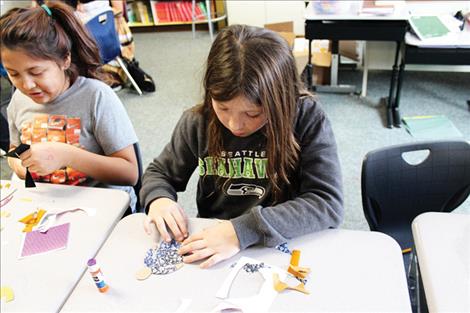Community, culture, connection celebrated during Native American Heritage Day
Hey savvy news reader! Thanks for choosing local.
You are now reading
2 of 3 free articles.
POLSON — Teachers and community members came together at Polson Middle School recently to celebrate Native American heritage.
The school’s seventh annual Native American Heritage Day was held the day before Thanksgiving break. Teacher and organizer Amy Williams explained that days before vacation are often filled with movies and missed learning time. “We wanted to take a day that might’ve been not much of anything and turn it into a valuable learning experience, bringing our community in and having our students be teachers as well,” Williams said.
With that in mind, Williams, former librarian Louanne Krantz, FCS teacher Terry Calahan, fifth grade teacher Valerie Rogers, community members and Indian Education Committee members organized and volunteered at the annual event. With rotating activities each year, the teachers looked to Knowledge Keepers to see what they would like to bring to the classrooms.
Knowledge Keepers Rosemary Caye and Elder Myrna Dumontier participated in this year’s activities. In the morning, Caye worked with sessions of seventh and eighth graders on small weaving projects that could be completed by the end of the class, and Dumontier came in to help.
“My grandmother and my teachers always said that when you’re learning something new, you don’t start off knowing how to do something well. You keep at it,” Dumontier said. Having to undo weaving and start over trained the muscles in her hands, her brain, and her arms. She said it taught her to get a feel for the kind of tension needed and got her familiar with the materials.
As students wove their baskets, Caye and Dumontier talked about where they go to get materials, how to harvest them, and what tribes had their meeting places in different parts of the region. Weaving increases hand eye coordination and muscle memory that trains the body for other tasks too. “Weaving isn’t just weaving and artistry, it’s also training your body to become more flexible and more utilitarian. More calm,” Dumontier stated. “It’s teaching kids to think about their whole world, not just their school world or their world at home.”
“When you sit down and go to work, everything else kind of goes away. It helps you keep a perspective on things,” Caye added.
With the fifth and sixth graders, the Knowledge Keepers played a Ksanka language game similar to Simon Says called “Skinku¢ Qakinni – Coyote Says” that integrates sign language. The educational game teaches native language while encouraging dance and play. “We had a great time, it was lots of fun,” Caye laughed.
Many other community members also contributed to the day’s activities. PMS math teacher Carrie Lapierre, someone Williams stated was instrumental since the beginning, spent extra time outside of school to help with planning and preparation, and incorporates Indian Education into all her classrooms. Tribal Education Department Head Michelle Mitchell and Elder and Culture and Language Studies Program Director Tim Ryan, Salish language instructor Linda Ferris, and their cultural apprentices Jane Gardipe, Giddy Woodcock, John Stevens, and Salish language teacher Malia Vanderberg also jumped in and taught sessions for students, gave out prizes, and provided support throughout the day. Over 30 student leaders helped support the community presenters and teach sessions. With five teacher leaders for sessions throughout the day, and parent and Indian Education Committee volunteer D’Arcy Ellis donating over two days of time, Williams said the meaningful day was able to happen entirely thanks to group effort, support, and guidance from so many adults and youths.
“You can only learn so much in a book, but when you have our cultural experts and our knowledge keepers that’re right here with us, why not sit down and have a conversation where we’re learning together? Everybody can be the student, and everybody can be the teacher,” Williams commented.
“We’re sharing our culture, and we’re bringing together everyone, not just our own people. We’re sharing and learning, and getting to know one another,” Caye said. “We’re breaking down barriers, and to me that was really exciting, and the kids absolutely loved it … It helps build connections and friendships, and that’s what we need to do. Building community. We’re all alike, we all have knowledge to share.”
“We’ve got other tribal kids from other tribes, descendants from other tribes, we’ve got non-tribal people who are very interested in knowing and understanding Native culture. It’s a time of growth and reinforcement of identity, it’s a time of introspection to just come to understand each other better, to appreciate each other better,” Dumontier agreed. “It affirms our community has reached the level of acceptance and wellness to do the right thing for each other. And acknowledging each other is really important, and holding each other in high esteem … The only way our children are ever going to learn how to do that is if we as the teachers, the adults in the room, are practicing and living that ourselves.”















.jpg)
.jpg)

.jpg)
